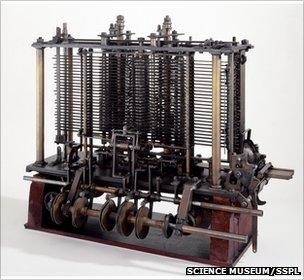Babbage Analytical Engine designs to be digitised
- Published

A project to construct one of the earliest mechanical computers based on sketches by its designer, Charles Babbage, has received a major boost.
The Science Museum in London has agreed to help by digitising the mathematician's original plans.
Eventually the images will be used to create a full working model of the Analytical Engine.
Conceived in the late 1830s, it foreshadowed the modern computer revolution by more than a century.
Babbage's many notepads and sketch books are currently held in the Science Museum's archives, but have never been converted into a form that is easily accessible.
It is hoped that the digital documents will allow researchers around the world to pick apart the many disparate ideas and settle on the definitive version of the machine.
"There are some complete plans, they are just not totally complete. There will be a degree of interpretation," said John Graham-Cumming, the programmer who has been championing the project.
Mr Graham-Cumming explained that, following a period of study, a computer simulation of the Analytical Engine would be produced before its eventual construction.
"The machine itself is going to be enormous, about the size of a small steam train, so the simulation is important to allow anyone access," added Mr Graham-Cumming.
Computing power
Another key figure in the drive to build the Analytical Engine is Doron Swade, the Science Museum's former curator of computing who led the project to build Babbage's earlier design, the Difference Engine No.2.
Where the Difference Engine was essentially an early calculator, the more sophisticated Analytical Engine is closer to a complete computer, with input via punched cards, processing by its rotating mechanical barrels and output to a printer, plotter or ringing bell.
In terms of processing power, Mr Graham-Cumming said it was possible to make some rough estimates about the Analytical Engine's capability.
Its memory would be equivalent to around 675bytes, or just over half that of Sinclair's ZX81, released in 1981. A later proposal by Babbage called for 20KB of storage.
The machine's clock speed would work out at around 7Hz, compared to the ZX81's 3.2MHz. Current high end microprocessors currently run at around 3GHz, although their sophisticated architecture means they are many, many times more powerful.
"[The Analytical Engine] is actually quite fast given that it's all in cogs, so Babbage was thinking about something relatively powerful. Of course, we're far beyond that now," said Mr Graham-Cumming.
The project does not yet have a fixed timescale, although it was unlikely to produce anything physical for "at least five years".
Mr Graham-Cumming said he had set the goal of completing it by 2021 - the 150th anniversary of Charles Babbage's death.
- Published14 October 2010
- Published10 May 2008